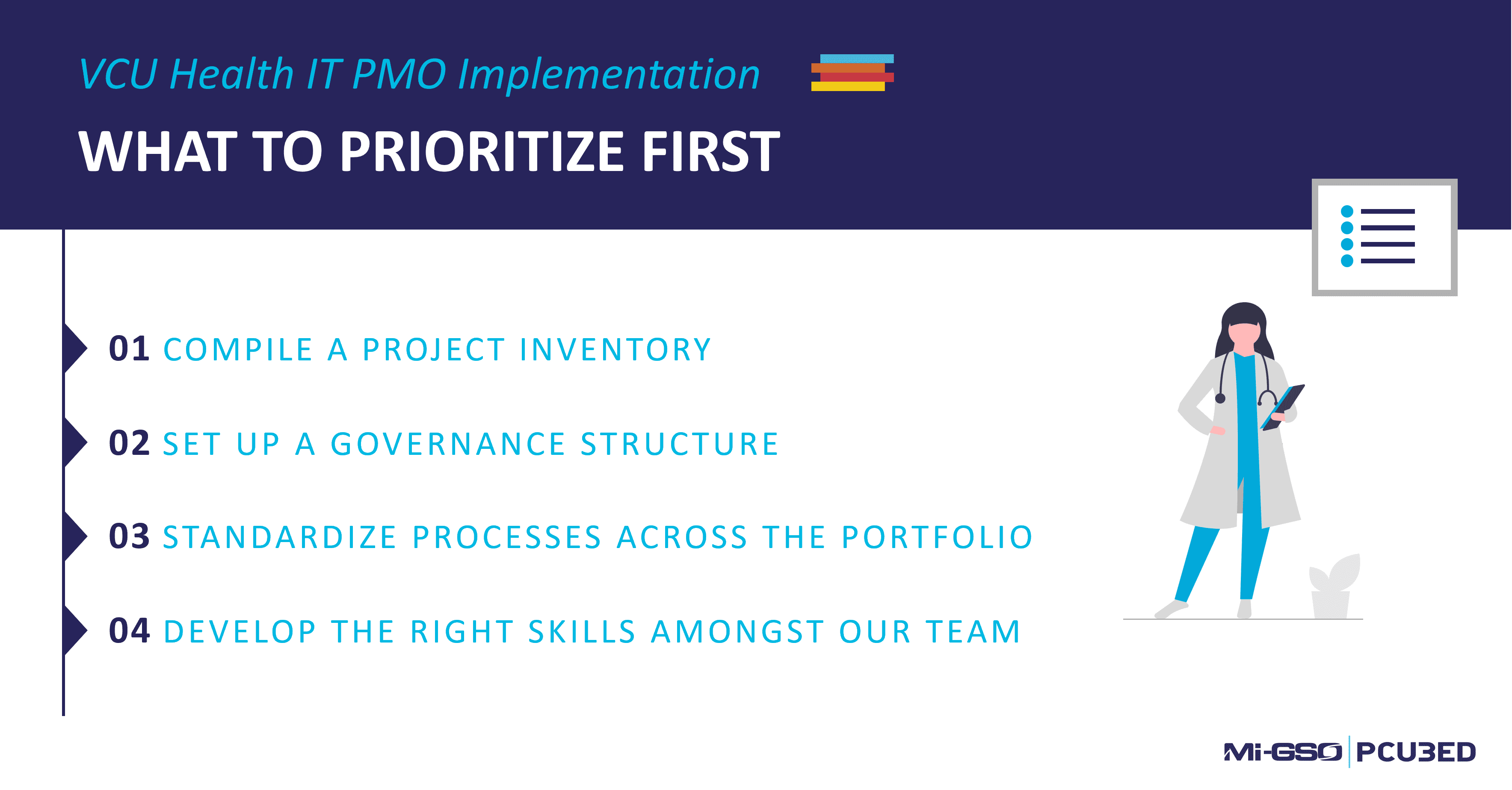Our website is not supported on this browser
The browser you are using (Internet Explorer) cannot display our content.
Please come back on a more recent browser to have the best experience possible

VCU Health is an academic health system focused on preserving and restoring the health of the people of Virginia. Their organization spans clinical research, education, patient health, hospital care, and community involvement. With a wide set of programs that each impact their health services, it’s imperative they have good project management to focus on the right projects, manage funding, and maintain staffing.
We spoke to VCU Health to understand how their IT PMO helped the organization to successfully deliver its diverse portfolio of initiatives, for example building a new medical facility, all while in the midst of a pandemic.
“Our PMO is here to help manage the resources for the IT department as a whole, as it relates to technology projects,” said Katie McCullough, director of the IT PMO and IT Quality Assurance. “We help support the technology governance process for the organization. Additionally, our PMO provides the Project Managers and Business Analysts needed to carry initiatives or system implementations selected by the Governance Council.”
“PMO structure and Project Management roles in general are becoming increasingly important for the healthcare industry,” added Marc Villamiel, Program Manager of Electronic Health Records.
“Reducing cost, reducing risk, and improving outcomes: these ultimately affect all of us in a personal way. We see the PMO as the engine to help bring together the people, tools, and processes to overcome these challenges. So, while we run behind the scenes to keep the organization running smoothly, it keeps us focused knowing our work directly relates to the quality of health services people receive.”
Reducing cost, reducing risk, and improving outcomes: these ultimately affect all of us in a personal way.
We see the PMO as the engine to help bring together the people, tools, and processes to overcome these challenges.Marc Villamiel, Program Manager of Electronic Health Records
“We had a PMO in the past, but it consisted of about 90% contractors and lacked strong governance,” said Katie. “Our CIO at the time saw the value of governance in a large healthcare organization.
She also understood that the project managers running these large multi-million-dollar projects were the face of IT, so she emphasized the necessity of strong PM fundamentals. We needed to make sure our PM processes were robust enough to deliver our portfolio of technology initiatives. This was the journey we laid out to mature our IT PMO.”
Read also: How to set up your PMO
“One of the main questions as a leader is ‘What is everybody doing?’” Katie said. “It was surprising when the CIO asked leadership to show their portfolio of technology projects, and they didn’t have that visibility.
It’s very difficult to prioritize work when you don’t have a list of projects, so compiling a Project Inventory was the first challenge the PMO set out to address. We needed to bring visibility and clarity on what projects were in flight and which ones were next up.
Second, once we had our inventory of work defined, we then put a governance structure in place and standardized our processes across the portfolio. Before then, everybody was doing their own thing. Now we have consistency in our processes, which is very important. We then created the Technology Governance Council, consisting of around 30 C-Suite executives. This allowed our PMO to be business-led, but with IT direction.
Finally, as I highlighted before, we needed the right skills amongst our team as well as consistency in delivering the message across the business. Many of our competencies come from PMI which is our standard. However, getting the right skill set on our team extends beyond just the leadership and governance of the PMO. We established a career ladder and continually work to develop our team’s skills. We want to grow and develop together and are investing in our team to do so.”

“These initial priorities were very important for us to get established,” added Marc. “Getting the right foundation in place is key for any organization. Before our PMO, we couldn’t do that. Now we have the core processes in place to add bells and whistles. That is, we are now well-positioned to innovate, which is important for our continued growth and development.”

“As Katie and Marc said, we focused first on our people and our processes,” said Tim Adams, Program Manager for Third Party System Applications. “Then with that foundation set, we could look at how to make our project management solutions and technology work best for us.”
“Our PMO has focused on staying on top of new technologies,” said Katie. “When I started, our weekly status reports were very manual. We’ve gone from that to now providing dynamic status reports with minimal input from the PMs. Just that one example is amazing in the changes we’ve made, and that of course is also thanks to our partnership with MP.”
Learn more about Digital Dashboards.
“We are very digital,” added Tim. “We are Microsoft cloud-based, and that allows us to be very collaborative and automated, tying all the things we need from a project intake perspective through to project delivery. We implemented Microsoft Project Online with Power BI for reporting and we started using Project Online’s resource management capabilities to look at capacity vs demand. We now have reporting and resource visibility at our hands as well as team collaboration functionality through the Microsoft suite.
‘Digital’ is the best way to describe what our team looks like, and as we continue to expand, we are looking at how to improve on that. Future-focused, we are looking at how team members can better adopt and use the things we put in place. Usability, that’s where we’re headed.”
“Our projects are business-imperatives, so we take on some significant programs,” said Marc. “We are an academic center as well as a health system. Our mission is to restore the health and wellbeing of the community through health services and education. Any initiative or project we do is tied to our mission and to our strategic objectives: safety, patient experience, workforce engagement, and clinician experience.”

“When our IT PMO started, our electronic health record system was over 15 years old. It was a ‘best of breed system’ at the time but did not integrate and communicate well with other systems in our technology stack. More problematic, it did not have the patient at the center.
Over the course of the past two and a half years, we changed enterprise foundation systems. We did a total overhaul of our enterprise resource planning system – which affected everyone in the organization – close to 16 thousand people. We transitioned our electronic health records system to another vendor. We expanded and built a new 17 story building that centralized most of our clinics in downtown Richmond, making it easier for patients to get to their appointments. These were pretty significant changes for our PMO to help drive. Now we have a better overall system. This allows us to be patient-focused and to leverage technology to provide better services for our patients and better support for our clinicians.”

“The PMO was a huge value to the business during the pandemic,” said Katie. “Overnight the company’s focus shifted. We worked with the business to understand which IT Technology projects were not mission-critical. Through our PPM solution, we had visibility of what projects our resources were working on. Therefore, we were well-positioned to pivot resources to projects that would better support our patients and health providers in responding to the crisis. Then, when that first wave was over, we worked together to shift our Project Managers back to supporting technology projects on our IT Roadmap. The PMO was able to coordinate this.”
“When you think about a PMO before the pandemic in terms of resource constraint – demand vs. supply was the key factor,” added Marc. “Now, the added dynamic is: are people healthy, are people safe? We now have to focus on that at the same time as ensuring project delivery.
“It’s amazing to think about what the organization has accomplished over the past two years, and during a pandemic,” said Craig Berkley, Program Manager for Infrastructure and Construction Work. “A great example of this is in the new building we completed.
Construction project management is always challenging. Anytime these large-scale projects happen, there is always schedule compression. Because IT is dependent upon so much upstream, that window was very, very tight. The bulk of our work was done in 6-8 weeks.”

“In the case of our latest building, the go-live was 2 days after our electronic health records (EHR) go-live date – in the middle of a pandemic. Our EHR went live on December 4th and then we moved into a new building 2 days later. It was crazy, but we did it.
One of the ways we were able to accomplish this was in collaborating with other teams. The key is in how we work with others. We communicate with the surrounding areas we support and are able to grow with them.”
“The value of the IT PMO is helping folks to not step on each other, ensuring the cross coordination with other parts of the business and the enterprise PMO,” said Tim. “There is a limited resource pool, and this past year we went through some very significant changes across our projects. Without the IT PMO, these projects would never have been pulled off.
Our PMs are well-adapted to address challenges before they become challenges, and we align everyone on this. We ensure there’s appropriate visibility for leadership to make the right decisions in line with their strategy.”

“Thank you for this spotlight on our team,” said Katie. “We are excited about the direction of our IT PMO and the growth for our organization. We’ve also learned some valuable lessons along the way. So, for any organization looking to implement or improve their PMO, here are four recommendations:
Don’t let perfect get in the way of better. Our CIO always asked the question, ‘Is it better than what we have now?’ If the answer is ‘yes’, move ahead.
Katie McCullough, director of the IT PMO and IT Quality Assurance
Thank you, Katie, Marc, Tim, and Craig, for taking the time to share VCU Health’s IT PMO journey with us. The healthcare industry has certainly faced challenges lately, including many rapid changes. We are excited for VCU Health and its ability to provide quality services and medical care throughout these changes. Their IT PMO sets a great example for how organizations in this sector can overcome challenges by leveraging their tools, allocating resources well, and aligning their projects to strategic objectives.
Interviewed by Elaina Wheeler and Jami Anderson.
Loved what you just read?
Let's stay in touch.
No spam, only great things to read in our newsletter.
We combine our expertise with a fine knowledge of the industry to deliver high-value project management services.
MIGSO-PCUBED is part of the ALTEN group.
Find us around the world
Australia – Canada – France – Germany – Italy – Mexico – The Netherlands – Portugal – Romania – South East Asia – Spain – Switzerland – United Kingdom – United States
© 2024 MIGSO-PCUBED. All rights reserved | Legal information | Privacy Policy | Cookie Settings | Intranet
Perfect jobs also result from great environments : the team, its culture and energy.
So tell us more about you : who you are, your project, your ambitions,
and let’s find your next step together.
Dear candidates, please note that you will only be contacted via email from the following domain: migso-pcubed.com. Please remain vigilant and ensure that you interact exclusively with our official websites. The MIGSO-PCUBED Team
Choose your language
Our website is not supported on this browser
The browser you are using (Internet Explorer) cannot display our content.
Please come back on a more recent browser to have the best experience possible
